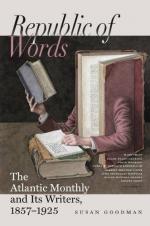The characters of the novel also show how deeply it has been meditated; for, though none of them may excite the personal interest which clings to Sam Weller or little Dombey, they are better fitted to each other and to the story in which they appear than is usual with Dickens. They all combine to produce that unity of impression which the work leaves on the mind. Individually they will rank among the most original of the author’s creations. Magwitch and Joe Gargery, Jaggers and Wemmick, Pip and Herbert, Wopsle, Pumblechook, and “the Aged,” Miss Havisham, Estella, and Biddy, are personages which the most assiduous readers of Dickens must pronounce positive additions to the characters his rich and various genius had already created.
Pip, the hero, from whose mind the whole representation takes its form and color, is admirably delineated throughout. Weak, dreamy, amiable, apprehensive, aspiring, inefficient, the subject and the victim of “Great Expectations,” his individuality is, as it were, diffused through the whole narrative. Joe is a noble character, with a heart too great for his powers of expression to utter in words, but whose patience, fortitude, tenderness, and beneficence shine lucidly through his confused and mangled English. Magwitch, the “warmint” who “grew up took up,” whose memory extended only to that period of his childhood when he was “a-thieving turnips for his living” down in Essex, but in whom a life of crime had only intensified the feeling of gratitude for the one kind action of which he was the object, is hardly equalled in grotesque grandeur by anything which Dickens has previously done. The character is not only powerful in itself, but it furnishes pregnant and original hints to all philosophical investigators into the phenomena of crime. In this wonderful creation Dickens follows the maxim of the great master of characterization, and seeks “the soul of goodness in things evil.”
The style of the romance is rigorously close to things. The author is so engrossed with the objects before his mind, is so thoroughly in earnest, that he has fewer of those humorous caprices of expression in which formerly he was wont to wanton. Some of the old hilarity and play of fancy is gone, but we hardly miss it in our admiration of the effects produced by his almost stern devotion to the main idea of his work. There are passages of description and narrative in which we are hardly conscious of the words, in our clear apprehension of the objects and incidents they convey. The quotable epithets and phrases are less numerous than in “Dombey & Son” and “David Copperfield”; but the scenes and events impressed on the imagination are perhaps greater in number and more vivid in representation. The poetical element of the writer’s genius, his modification of the forms, hues, and sounds of Nature by viewing them through the medium of an imagined mind, is especially prominent throughout the descriptions with which the work abounds. Nature is not only described, but individualized and humanized.




